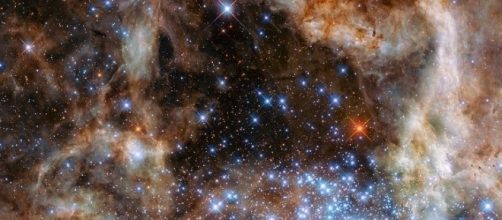The dip in the brightness of star Kic 8462852 is a mystery that has puzzled scientists over the past few years. Now a new study carried out by researchers at the University Of Arizona suggests that this dip in the brightness of KIC 8462852 could be due to a giant, irregular Dust Cloud moving around the star.
KIC 8462852 has perplexed scientists
KIC 8462852— also known as Boyajian’s star or Tabby’s star—is located about 1,400 light years away from Earth. In 2015, this star hugely perplexed scientists when it was revealed that the brightness of the star changes very irregularly.
Tabetha Boyajian, an astronomer from Yale, was the first to observe this odd behavior of the star.
Boyajian found that the dimming of KIC 8462852 was irregular, and the level of dimming also varied from time to time. Last month, the brightness of the star was found to have dropped by about three percent. According to researchers, the brightness of this star has even dropped by huge 22 percent in the past.
Scientists say it is normal to notice a little drop in the amount of light coming from a star. It happens when a planet/object passes in front of the star. However, such dips in star’s light occur at regular intervals and the same amount of light is blocked each time. This is not the case with KIC 8462852 however.
Theories proposed to explain the strange behavior
The Scientific Amercian explains that over the past few years, several theories have been proposed by scientists to explain the strange behavior of KIC 8462852. These include the presence of a swarm of comets near the star; a huge ringed planet passing in front of the star; something strange occurring inside the star and the presence of space junk. Some people also proposed an alien megastructure theory to explain the dimming of the star.
In the latest study, led by Huan Meng of the University of Arizona, researchers used survey data from NASA’s Swift and Spitzer missions to analyze the dimming of light in different wavelengths. They also observed the star for several months in 2016 and found that there was less dip in brightness when the star was seen using infrared light compared to when it was seen in ultraviolet light.
Particles blocking the light are bigger than interstellar dust
These findings indicate that the particles blocking the light are bigger than interstellar dust because if dimming was due to anything larger than interstellar dust particles, its amount would have been the same in infrared as well as ultraviolet wavelengths. The team believes that a massive, irregular cloud of circumstellar dust is probably orbiting KIC 8462852 with an orbital period of approximately 700 days.
However, this theory also comes with its own weakness as it does not explain the 20 percent dip in the light of the star. Scientists believe further research is needed to fully solve the puzzle behind KIC 8462852.
The detailed findings of the latest study were published in The Astrophysical Journal.


